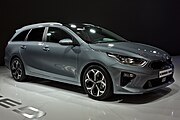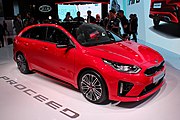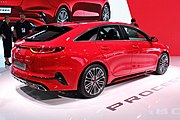Kia Ceed (CD)
| Kia | |
|---|---|
|
Kia Ceed (since 2018)
|
|
| Ceed | |
| Production period: | since 2018 |
| Class : | Compact class |
| Body versions : | Station wagon |
| Engines: |
Otto engines : 1.0–1.6 liters (73–150 kW) Otto hybrid : 1.6 liters (104 kW) Diesel engines : 1.6 liters (85–100 kW) |
| Length: | 4310-4605 mm |
| Width: | 1800 mm |
| Height: | 1422-1465 mm |
| Wheelbase : | 2650 mm |
| Empty weight : | 1260-1533 kg |
| Previous model | Kia cee'd (JD) |
| Stars in the Euro NCAP - crash test 2019 in the basic configuration |
|
| Stars in Euro NCAP - crash test 2019 with safety package |
|
The Kia Ceed is the third generation of the car model modeling cee'd the Korean automobile manufacturer Kia Motors . It was presented in spring 2018 and is based on the Hyundai i30 (PD) . Unlike the first two generations of the vehicle is with a capital letter and without apostrophe as Ceed marketed. The XCeed crossover SUV shares the platform with the third generation Ceed.
history
The five-door hatchback and the station wagon were presented at the 88th Geneva Motor Show in March 2018. The five-door model went on sale on June 30, 2018, the station wagon followed in September 2018. At the Paris Motor Show in October 2018, Kia presented the ProCeed, a shooting brake, and the Ceed GT, a sporty variant. The model replaces the Kia cee'd (JD) built since April 2012 .
Since January 2020, the station wagon has also been available with the plug-in hybrid drive familiar from the Niro .
The Ceed is built together with the Kia Sportage in Žilina, Slovakia .
body
The body is based on the new K2 platform and is more rigid. So far, three variants are offered:
| five-door hatchback | five-door station wagon | five-door shooting brake | |
|---|---|---|---|
| Construction period | since June 2018 | since September 2018 | since December 2018 |
| Length × width × height | 4310-4325 mm × 1800 mm × 1442-1447 mm | 4600-4605 mm x 1800 mm x 1460-1465 mm | 4605 mm × 1800 mm × 1422 mm |
| wheelbase | 2650 mm | ||
| Tank capacity | 50 l | ||
Kia Ceed & Kia Ceed SW at the presentation at the Geneva Motor Show 2018 by COO Michael Cole
landing gear
The Ceed has MacPherson struts at the front and a multi- link axle at the rear . Compared to its predecessor, there have been many detailed changes to the chassis - including new bushings for handlebars and shock absorbers, modified spring rates, and different stabilizers .
safety
In mid-2019, the Ceed was tested for vehicle safety by Euro NCAP . In the basic version, the car received four out of five possible stars. Since a safety package is optionally available for the model, the Ceed was also tested with the safety package. In this test, it received five stars out of five.
Technical specifications
When the Ceed is launched, there will be a choice of three gasoline engines and a diesel engine in two power levels. The most powerful engines in each case are also available with a 7-speed dual clutch transmission . All engines are also available in the third generation of the Hyundai i30 . A sporty GT version is also back in the pipeline, but it is not on the Hyundai i30 N build. At the beginning of 2020, a plug-in hybrid version with the drive from the Kia Niro PHEV was also launched on the market for the Ceed Kombi. Depending on the development of demand, this will also be offered later for the 5-door.
| 1.0 T - GDi | 1.4 | 1.4 T-GDi | 1.6 T-GDi | 1.6 GDI plug-in hybrid | 1.6 CRDi 115 | 1.6 CRDi 136 | ||
|---|---|---|---|---|---|---|---|---|
| Construction period: | since 08/2019 | since 06/2018 | 06/2018–08/2019 | since 06/2018 | since 12/2018 | since 01/2020 | since 06/2018 | |
| Engine type: | R3 petrol engine | R4 petrol engine | R4 petrol engine + electric motor | R4 diesel engine | ||||
| Motor type: | Three-cylinder in- line engine with direct injection and turbocharger |
Four-cylinder in-line engine with manifold injection | Four-cylinder in-line engine with direct injection and turbocharger |
Four-cylinder in-line engine with direct injection |
Four-cylinder diesel engine with direct injection and turbocharger |
|||
| Displacement : | 998 cc | 1368 cc | 1353 cc | 1591 cc | 1580 cc | 1598 cc | ||
|
Max. Power at min-1: |
74 kW (100 PS) / 4500 |
88 kW (120 PS) / 6000 |
73 kW (99 PS) / 6000 |
103 kW (140 PS) / 6000 |
150 kW (204 PS) / 6000 |
104 kW (141 hp) / 5700 (1) |
85 kW (115 PS) / 4000 |
100 kW (136 PS) / 4000 |
|
Max. Torque at min-1: |
172 Nm / 1500-4000 | 134 Nm / 3500 | 242 Nm / 1500-3200 | 265 Nm / 1500-4500 | 265 Nm / 1000-2400 (2) | 280 Nm / 1500-2750 | 280 Nm / 1500–3000 [320 Nm / 2000–2250] |
|
| Drive type: | Front wheel drive | |||||||
| Gearbox, as standard: | 6-speed manual transmission | 6-speed DCT | 6-speed manual transmission | |||||
| Gearbox, optional: | - | [7-speed DCT] | - | [7-speed DCT] (3) | [7-speed DCT] | |||
|
Top speed, hatchback: |
183 km / h | 187-190 km / h | 183 km / h | 208–210 km / h [206 km / h] |
230 km / h [225 km / h] |
- | 192 km / h [192 km / h] |
198–200 km / h [200 km / h] |
|
Top speed, station wagon: |
183 km / h | 190 km / h | 183 km / h | 208–210 km / h [206 km / h] |
- | 171–200 km / h 120 km / h el. |
192 km / h [192 km / h] |
200 km / h [200 km / h] |
|
Top speed, Shooting Brake: |
- | 190 km / h | - | 210 km / h [205 km / h] |
230 km / h [225 km / h] |
- | 200 km / h [200 km / h] |
|
|
Acceleration, 0-100 km / h, hatchback: |
11.8 s | 11.1-11.3 s | 12.6 s | 8.9–9.1 s [9.2 s] |
7.5 s [7.4 s] |
- | 10.9 s [10.9 s] |
10.2-10.4 s [9.9 s] |
|
Acceleration, 0-100 km / h, station wagon: |
12.0 s | 11.3 s | 12.9 s | 9.1–9.3 s [9.4 s] |
- | 10.8 s | 11.1 s [11.1 s] |
10.4 s [10.1 s] |
|
Acceleration, 0-100 km / h, Shooting Brake: |
- | 11.1 s | - | 9.1 s [9.4 s] |
7.6 s [7.7 s] |
- | 10.4 s [10.1 s] |
|
|
Fuel consumption over 100 km (combined), hatchback: |
5.2–5.5 l super | 5.4-5.6 l super | 6.0–6.4 l super | 5.6–5.9 l super [5.7 l super] |
6.8 l super [6.2 l super] |
- | 4.0 l diesel [4.0–4.2 l diesel] |
4.0–4.3 l diesel [4.3 l diesel] |
|
Fuel consumption over 100 km (combined), station wagon: |
5.2–5.5 l super | 6.1–6.4 l super | 5.6–5.9 l super [5.5–5.7 l super] |
- | 1.1-1.3 l Super + 9.3-11.2 kWh |
3.9-4.0 l diesel [4.0-4.1 l diesel] |
3.9–4.3 l diesel [4.2–4.3 l diesel] |
|
|
Fuel consumption per 100 km (combined), Shooting Brake: |
- | 5.2–5.5 l super | - | 5.7–5.9 l super [5.5–5.9 l super] |
6.8 l super [6.2 l super] |
- | 3.9–4.3 l diesel [4.2–4.3 l diesel] |
|
|
CO 2 emissions, combined, hatchback: |
118-126 g / km | 122-128 g / km | 137-145 g / km | 128–135 g / km [129 g / km] |
155 g / km [142 g / km] |
- | 104 g / km [105–108 g / km] |
104–111 g / km [111 g / km] |
|
CO 2 emissions, combined, combination: |
118-126 g / km | 120-126 g / km | 139-145 g / km | 128–135 g / km [125–129 g / km] |
- | 28-34 g / km | 101-104 g / km [105-108 g / km] |
104–111 g / km [109–111 g / km] |
|
CO 2 emissions, combined, Shooting Brake: |
- | 118-126 g / km | - | 130–135 g / km [125–133 g / km] |
155 g / km [142 g / km] |
- | 104–111 g / km [109–111 g / km] |
|
| Emissions standard according to EU classification: | Euro 6d-TEMP | |||||||
Web links
Individual evidence
- ↑ a b c d e This is how the new compact model feels. In: auto-motor-und-sport.de. February 15, 2018, accessed February 15, 2018 .
- ↑ Gregor Hebermehl, Uli Baumann, Peter Wolkenstein: Kia ProCeed GT and Ceed GT in the driving report: Shooting Brake visually and drivingly crisp. In: auto-motor-und-sport.de. September 13, 2018, accessed September 13, 2018 .
- ↑ Bernd Conrad: Compact plug-in hybrids. In: autonotizen.de. September 3, 2019, accessed September 3, 2019 .
- ↑ Five stars for e-cars: EuroNCAP crack test. In: welt.de . July 3, 2019, accessed July 3, 2019 .
- ↑ https://www.heise.de/autos/artikel/Vorstellung-Kia-Ceed-Sportswagon-PHEV-4629562.html








